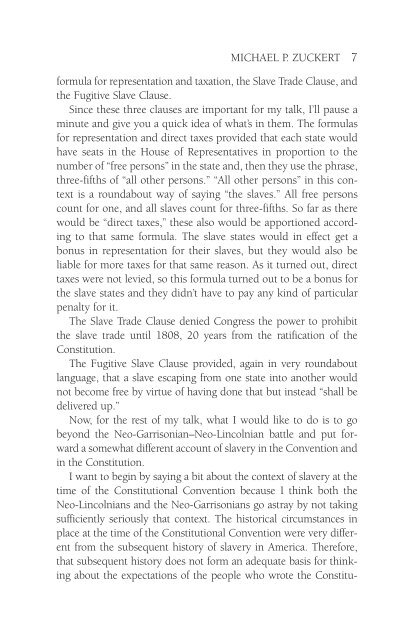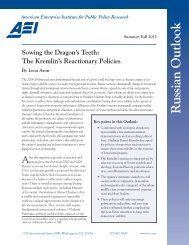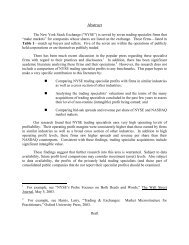Download the PDF - American Enterprise Institute
Download the PDF - American Enterprise Institute
Download the PDF - American Enterprise Institute
You also want an ePaper? Increase the reach of your titles
YUMPU automatically turns print PDFs into web optimized ePapers that Google loves.
MICHAEL P. ZUCKERT 7<br />
formula for representation and taxation, <strong>the</strong> Slave Trade Clause, and<br />
<strong>the</strong> Fugitive Slave Clause.<br />
Since <strong>the</strong>se three clauses are important for my talk, I’ll pause a<br />
minute and give you a quick idea of what’s in <strong>the</strong>m. The formulas<br />
for representation and direct taxes provided that each state would<br />
have seats in <strong>the</strong> House of Representatives in proportion to <strong>the</strong><br />
number of “free persons” in <strong>the</strong> state and, <strong>the</strong>n <strong>the</strong>y use <strong>the</strong> phrase,<br />
three-fifths of “all o<strong>the</strong>r persons.” “All o<strong>the</strong>r persons” in this context<br />
is a roundabout way of saying “<strong>the</strong> slaves.” All free persons<br />
count for one, and all slaves count for three-fifths. So far as <strong>the</strong>re<br />
would be “direct taxes,” <strong>the</strong>se also would be apportioned according<br />
to that same formula. The slave states would in effect get a<br />
bonus in representation for <strong>the</strong>ir slaves, but <strong>the</strong>y would also be<br />
liable for more taxes for that same reason. As it turned out, direct<br />
taxes were not levied, so this formula turned out to be a bonus for<br />
<strong>the</strong> slave states and <strong>the</strong>y didn’t have to pay any kind of particular<br />
penalty for it.<br />
The Slave Trade Clause denied Congress <strong>the</strong> power to prohibit<br />
<strong>the</strong> slave trade until 1808, 20 years from <strong>the</strong> ratification of <strong>the</strong><br />
Constitution.<br />
The Fugitive Slave Clause provided, again in very roundabout<br />
language, that a slave escaping from one state into ano<strong>the</strong>r would<br />
not become free by virtue of having done that but instead “shall be<br />
delivered up.”<br />
Now, for <strong>the</strong> rest of my talk, what I would like to do is to go<br />
beyond <strong>the</strong> Neo-Garrisonian–Neo-Lincolnian battle and put forward<br />
a somewhat different account of slavery in <strong>the</strong> Convention and<br />
in <strong>the</strong> Constitution.<br />
I want to begin by saying a bit about <strong>the</strong> context of slavery at <strong>the</strong><br />
time of <strong>the</strong> Constitutional Convention because I think both <strong>the</strong><br />
Neo-Lincolnians and <strong>the</strong> Neo-Garrisonians go astray by not taking<br />
sufficiently seriously that context. The historical circumstances in<br />
place at <strong>the</strong> time of <strong>the</strong> Constitutional Convention were very different<br />
from <strong>the</strong> subsequent history of slavery in America. Therefore,<br />
that subsequent history does not form an adequate basis for thinking<br />
about <strong>the</strong> expectations of <strong>the</strong> people who wrote <strong>the</strong> Constitu-






